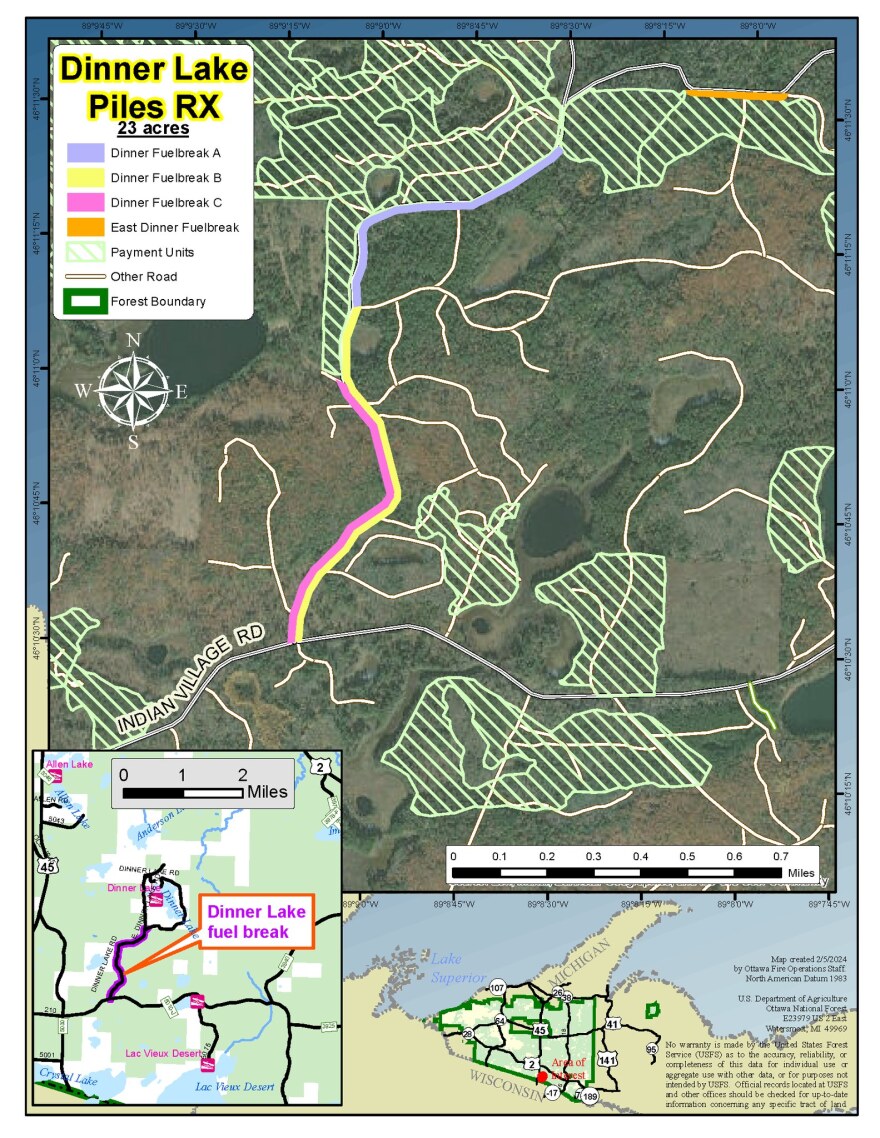Driving through the Ottawa National Forest north of Land O’Lakes towards Dinner Lake you’ll see snow-covered piles stacked up every few feet in the woods along the road.
Many of the piles are wood debris and branches left over from logging operations on the Ottawa.
Some of the piles have been waiting there for two years as the Forest Service let them dry out.
A couple weeks ago, fire crews started burning them.

Fire has long been used in forests to help with management.
Sometimes it’s used to improve wildlife habitat or reduce the risk of wildfires. In this case, it’s primarily being used to increase the safety of people who live nearby in the event of a major wildfire.
“This community of Dinner Lake is a one way in, one way out community,” said Forest Paukert, the West Zone Fire Management Officer for the Ottawa National Forest.
The Ottawa is more than 993,000 acres that spans across much of the western Upper Peninsula.
There are small towns and communities, like the Dinner Lake area, spread throughout it.
People that live there see a beautiful, secluded area.
People like Paukert see the risk to their homes and lives if a wildfire were to start in the area.
“Whether it's a wildfire in the community itself or a wildfire out here where it's going to affect the main road coming in and out, we want to reduce the chance of that wildfires impingement on the road,” he said. “We want to reduce that heat and intensity, give firefighters a place where they can attack the fire, also allow for fire trucks to get into the community while that's going on, along with the residents to get out of the community at the same time.”
The Forest Service is creating what Paukert calls a “shaded fuel brake” along Dinner Lake Road.

Over the last two summers, logging operations in the area have been reducing the number of trees on either side of the road as well as trimming the branches on the remaining trees so there are none for the first 10 feet off the ground.
Then crews from the Lac Vieux Desert Band of Lake Superior Chippewa came in and put all the wood debris and branches, along with brush and small trees, into piles along Dinner Lake Road.
This winter, fire crews from the National Forest Service have been burning them.
The end result is a shaded fuel brake which allows the remaining trees to provide shade and keep the soil moist while reducing the amount of fuel to burn in the event of a wildfire.
“That way, when a fire comes along and it moves into this shaded fuel break, that heat and intensity will drop. Also, the flame lengths, so how high the flames are going up in the air, that will drop as well,” said Paukert. “Generally, it'll allow the smoke to rise better and get out. It should keep the visibility along the road lower. It will keep that heat lower. Everybody will be able to see each other. That's the general intent of it.”

Studies have shown that fuel breaks increase the effectiveness of other wildfire suppression work.
This process is repeated every 10 years. That’s the average amount of time it takes for the forest to regrow and become a risk again.
This process is also being repeated in other parts of the Ottawa.
“We have quite a few of these types of projects on the forest, and we're looking to do more, especially in the wildland/urban interface. That's where the forest meets people that live out in the woods, basically. We're looking to do more of these to help the communities, to help the firefighters in the future,” said Paukert.
It’s an important and personal project for many members of this crew that live locally, one they’re reminded of every time a passerby stops to thank them for making their community safer.
“We're doing this for the benefit of the community,” said Paukert.
The remaining piles for the Dinner Lake project are expected to be burned in the Fall/Winter of 2024. The Forest Service is also waiting on a couple more timber sales to close to fully finish the project.









